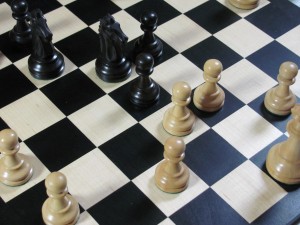Welcome to Purple Pawn, covering games played around the world by billions of people every day.
Artificial Intelligence Teaches Itself Chess
17 Sep
Posted by David Miller as Classic Board Games, Modern Board Games
 Computer programs for Chess are already quite adept, playing at a level that exceeds the best human grandmasters. Currently, though, they work on a brute-force approach, using raw processing power to evaluate all possible subsequent moves. That may change.
Computer programs for Chess are already quite adept, playing at a level that exceeds the best human grandmasters. Currently, though, they work on a brute-force approach, using raw processing power to evaluate all possible subsequent moves. That may change.
Matthew Lai, a graduate student at the Imperial College of London, has developed a Chess engine that, using neural networks, applies pattern recognition techniques to narrow the decision tree. The program, which Lai named Giraffe [PDF], honed its pattern recognition skills by playing against itself for a period of 72 hours and comparing the results of each decision to a database of Chess games.
Now after considering the global state of the game, piece-specific factors, and a map of the spaces threatened and defended, Giraffe is able to predict the best move 46 percent of the time and select a top-three that includes that best move 70 percent of the time, all without looking ahead. This rates Giraffe at about the level of a FIDE International Master.
The beauty of this approach is in its generality. While it was not explored in this project due to time constraint, it is likely that this approach can easily be ported to other zero-sum turn-based board games, and achieve state-of-art performance quickly, especially in games where there has not been decades of intense research into creating a strong AI player.
[via MIT Technology Review]
No Comments
Sorry, the comment form is closed at this time.
Trending
- Massdrop.com
- Oh the Irony—Illuminati Card Game Continues to Inspire Conspiracy Theorists
- Home
- Footprints, an Educational Ecology Game
- USPS Adds Board Game Flat Rate Box
- Baila, the Estonian Drinking Card Game
- Crystal Caste Wins Dice Patent Suit Against Hasbro
- Mirror Game, Red and Blue
- Are Board Games Dangerous?
- The Truth About Dominoes On Sunday in Alabama
Archives
Most Popular Articles
- Oh the Irony—Illuminati Card Game Continues to Inspire Conspiracy Theorists
- The 20 Most Valuable Vintage Board Games
- The Truth About Dominoes On Sunday in Alabama
- Sequence Game, and Variants
- USPS Adds Board Game Flat Rate Box
- Baila, the Estonian Drinking Card Game
- The 13 Most Popular Dice Games
- Are Board Games Dangerous?
- Guess Who? The Naked Version
- What Happened to the Jewel Royale Chess Set?
Recent Posts
- Toy Fair 2019—Breaking Games
- Talisman Kingdom Hearts Edition
- Toy Fair 2019—Winning Moves
- Toy Fair 2019—Games Workshop
- Toy Fair 2019—Star Wars Lightsaber Academy
- Toy Fair 2019—Stranger Things Games
- Toy Fair 2019—HABA
- Licensing Roundup
- Game Bandit
- 2018 A Difficult Year For Hasbro But Not For D&D Or MtG
Recent Comments
- on Toy Fair 2019—Winning Moves
- on Game Bandit
- on Second Look—Dungeons & Dragons Waterdeep Dragon Heist
- on Crowdfunding Highlights
- on Beyblade SlingShock
- on Game Bandit
- on Game Bandit
- on Watch This Game!, the Board Game Review Board Game
- on Second Look—Vampire: The Masquerade 5th Edition
- on Palladium Books Loses Robotech IP License, Cancels Five-Year-Overdue Robotech RPG Tactics Kickstarter




